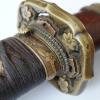Hi,
I have bought a nice Wakizashi from the Edo period. It’s signed Echizen no kami fujiwara yoshikado. It took me almost two hours to figure this out but I managed it on my own I’m learning…
The tang is also dated but I can only figure out the first to kanji characters. Kan ‘ei (1624-1644). Maybe one of you can tell me more about the date? The kanji characters on the kogatana are hard to read.
I have taken a lot of pictures. Hope you enjoy it. With the camera, I’m using it’s very hard to catch the hamon. The hamon is visible. There is some blade damage at the tip. I think there is some moisture in the saya or the blade was not wel protected by some oil.
Regards,
Ed



